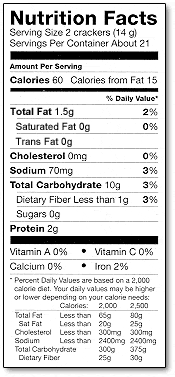Figuring Out Food Labels
You know how books have a table of contents that explains what's inside? Or maybe you've received a toy that came with a diagram that identified each small piece. Nutrition labels are sort of like that. They tell you what's inside the food you're eating and list its smaller parts.
 The Nutrition Facts food label gives you information about which nutrients (say: nu-tree-ents) are in the food. Your body needs the right combination of nutrients, such as vitamins, to work properly and grow. The Nutrition Facts food label is printed somewhere on the outside of packaged food, and you usually don't have to look hard to find it. Fresh food that doesn't come prepackaged sometimes has nutrition facts, too.
The Nutrition Facts food label gives you information about which nutrients (say: nu-tree-ents) are in the food. Your body needs the right combination of nutrients, such as vitamins, to work properly and grow. The Nutrition Facts food label is printed somewhere on the outside of packaged food, and you usually don't have to look hard to find it. Fresh food that doesn't come prepackaged sometimes has nutrition facts, too.
Most nutrients are measured in grams, also written as g. Some nutrients are measured in milligrams, or mg. Milligrams are very tiny - there are one thousand milligrams in a gram. Other information on the label is given in percentages. These numbers are based on eating 2,000 calories in a day, the amount that many school-age kids eat . A calorie is a unit of energy, a way of expressing how much energy you would get by eating a certain food.
If you want to learn more about the different types of information on food labels, keep reading. We'll start at the top of the label and work our way down.
Serving Size The nutrition label always lists a serving size, which is an amount of food, such as 1 cup of cereal, two cookies, or five pretzels. The nutrition label tells you how many nutrients are in that amount of food. Serving sizes also help people understand how much they're eating. If you ate 10 pretzels, that would be two servings.
Servings per Container or Package The label also tells you how many servings are contained in that package of food. If there are 15 servings in a box of cookies and each serving is 2 cookies, then you have enough for all 30 kids in your class to have one cookie each. Math comes in handy with food labels!
Calories and Calories From Fat The number of calories in a single serving of the food is listed on the left of the label. This number tells you the amount of energy in the food. People pay attention to calories because if you eat more calories than your body uses, you might gain weight.
Another important part of the label is the number of calories that come from fat. People check this because it's good to limit fat intake. The calories in a food can come from fat, protein, or carbohydrate.
Percent Daily Value You'll see percentages on food labels that are based on recommended daily allowances - meaning the amount of something a person should get each day. For instance, there's a recommended daily allowance for fat, so the food label might say that one serving of this food meets 10% of the daily value. The daily values are based on an adult's needs, not a kids' needs. These are often similar, but kids need may need more or less of certain nutrients, depending on their age and size.
Some percent daily values are based on the amount of calories and energy a person needs. These include carbohydrates, proteins, and fat. Other percent daily values - like those for sodium, potassium, vitamins, and minerals - stay the same no matter how many calories a person eats.
Total Fat The total fat is the number of fat grams contained in one serving of the food. Fat is an important nutrient that your body uses for growth and development, but you don't want to eat too much. The different kinds of fat, such as saturated, unsaturated, and trans fat, may be listed separately on the label.
Cholesterol and Sodium These numbers tell you how much cholesterol and sodium (salt) are in a single serving of the food. They are included on the label because some people need to limit cholesterol or salt in their diets. Cholesterol and sodium are usually measured in milligrams.
Total Carbohydrate This number tells you how many carbohydrate grams are in one serving of food. Carbohydrates are your body's primary source of energy. This total is broken down into grams of sugar and grams of dietary fiber.
Protein This number tells you how much protein you get from a single serving of the food. Your body needs protein to build and repair essential parts of the body, such as muscles, blood, and organs. Protein is often measured in grams.
Vitamin A and Vitamin C These list the amounts of vitamin A and vitamin C, two especially important vitamins, in a serving of the food. Each amount is given as a percent daily value. If a food provides 20% of the RDA for vitamin A, that one serving of food gives an adult one fifth of the vitamin A needed for the day.
Calcium and Iron These list the percentages of calcium and iron, two especially important minerals, that are in a serving of the food. Again, each amount is given as a percent daily value. If a food has 4% of iron, you're getting 4% of the iron you need for the whole day from that serving.
Calories per Gram These numbers show how many calories are in one gram of fat, carbohydrate, and protein. This information is the same for every food and is printed on the food label for reference.
Now that you know a little more about food labels, you can read up on what you're eating!
next: Guidelines for Significant Others
~ eating disorders library
~ all articles on eating disorders
APA Reference
Gluck, S.
(2008, December 25). Figuring Out Food Labels, HealthyPlace. Retrieved
on 2026, January 3 from https://www.healthyplace.com/eating-disorders/articles/figuring-out-food-labels



